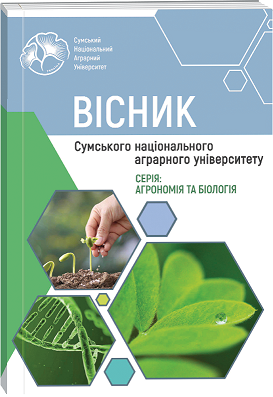ADAPTATION OF HAZELNUT VARIETIES IN THE CONDITIONS OF TRANSCARPATHIA
Abstract
The article highlights the results of research on the adaptation of 12 hazelnut varieties in the lowland subzone of Transcarpathia. The main purpose of the work was to study the biological characteristics of growth, development, fruiting and resistance to unfavorable environmental factors of the introduced hazelnut varieties. The study also examined the technological aspects of cultivation, including the effectiveness of disease and pest protection systems. The soil pests that cause significant damage to young plantations were assessed. To control them, it is recommended to apply the drug Force during the establishment of the garden and use Pirinex during the growing season. Schemes for the protection of hazelnut plantations with the use of such drugs as Champion, Topsin M, Fundazol, and Enjio, which demonstrate high efficiency in the fight against major diseases, including Fusarium, Verticillium, Alternaria, and powdery mildew, are presented. In addition, key pests were monitored: May beetle larvae, hazelnut weevil, hazelnut aphids and others. The results of biometric measurements indicate high adaptability of the varieties to local conditions. It was found that the diameter of the stems by the end of the growing season reached 28.0–31.7 mm, and in the variety Tonda di Gifoni – 35.9 mm, which is significantly higher than the control variety Darunok Yunatam. Significant total growth (180–391 cm) was observed in the varieties Lozovsky Bulavovidnyi, Francescana, Zhovtnevyi, Tonda di Gifoni, Mortarella, Dolynskyi, Nokyone and Svyatnichnyi. Particular attention is paid to the productivity of the varieties. In the third year after planting, fruiting was observed in all varieties except Zhovtnevyi and Karamanovskyi. The most large-fruited were Camponica, Francescana, Dolinsky and Tonda di Gifoni, the average weight of one nut of which was 3.2–4.4 g. The kernel yield reached 46.0-50% in varieties Darunok Yunatam, Tonda di Gifoni, Francescana and Mortarella. The obtained results indicate the high prospects of using the studied hazelnut varieties for industrial cultivation in Transcarpathia. Agrotechnical measures to increase the yield and resistance of plants, including effective systems of protection against diseases and pests, as well as recommendations for fertilization and care of the trunk strips, are proposed.
References
2. Boccacci, P., & Botta, R. (2020). Phenology and adaptability of hazelnut varieties in temperate regions. Forests. Access mode: https://www.mdpi.com
3. Caliskan, T., & Mehlenbacher, S. A. (2022). Yield and nut quality of hazelnut cultivars in different regions. ScienceDirect. Access mode: https://www.sciencedirect.com
4. Cristofori, V., & Liang, L. (2023). Advances in hazelnut germplasm and breeding programs. Forests, Special Issue on Hazelnut Genetic Improvement. doi: 10.3390/f14020321
5. Cristofori, V., & Monarca, D. (2020). Advances in genetic improvement of hazelnut. International Society for Horticultural Science (ISHS). Access mode: https://www.ishs.org/proceedings
6. Cristofori, V., Botta, R., Rovira, M., Molnar, T. J., & Mehlenbacher, S. A. (2023). Editorial: Recent advances in hazelnut (Corylus spp.). Frontiers in Plant Science, 13, Article 1120595. doi: 10.3389/fpls.2022.1120595
7. Hazelnut Hub. (2024). Adapting hazelnut orchards to climate change: Strategies for resilience. Access mode: https://hazelnuthub.com/climate-resilient-hazelnuts
8. Kosenko, I. S. (2015). Novyi sort funduka (Corylus domestica Kos. et Opal.) Sofiivskyi 15 : materialy mizhnarodnoi konferentsii. [New hazelnut variety (Corylus domestica Kos. et Opal.) Sofiivskyi 15: a proceedings of the international conference]. Introduktsiia roslyn, zberezhennia ta zbahachennia bioriznomanittia v botanichnykh sadakh ta dendroparkakh: materialy mizhnarodnoi naukovoi konferentsii, prysviachenoi 80-richchiu vid dnia zasnuvannia Natsionalnoho botanichnoho sadu im. M. M. Hryshka NAN Ukrainy, Ailant, Kyiv, 124–125 (in Ukrainian).
9. Kosenko, I. S., & Balabak, O. A. (2018). Vyrobnychi vyprobuvannia krashchykh sortiv funduka (Corylus domestica Kos. et Opal.) kolektsii NDP «Sofiivka» NAN Ukrainy: zbirnyk prats. [Production trials of the best hazelnut varieties (Corylus domestica Kos. et Opal.) from the NDP “Sofiyivka” collection of NAS of Ukraine: a collected volume]. Journal of Native and Alien Plant Studies. Ailant, Kyiv (in Ukrainian).
10. Kosenko, I. S., Opalko, A. I., & Opalko, O. A. (2008). Funduk: prykladna henetyka, selektsiia, tekhnolohiia rozmnozhennia i vyrobnytstva: bio. biulet. [Tolerance of hazelnuts towards unfavorable environmental factors: biological bulletin]. Ailant, Kyiv (in Ukrainian).
11. Król, K., & Gantner, M. (2020). Morphological traits and chemical composition of hazelnut from different geographical origins: A review. Agriculture, 10(9), Article 375. doi: 10.3390/agriculture10090375
12. Król, K., & Gantner, M. (2020). Morphological traits and chemical composition of hazelnut from different geographical origins: A review. Agriculture, 10(9), 375. doi: 10.3390/agriculture10090375
13. Liu, X., Chen, Y., & Zhao, J. (2020). Chromosome-level genome assembly and hazel omics database construction provide insights into unsaturated fatty acid synthesis and cold resistance in hazelnut (Corylus heterophylla). Plant Biotechnology Journal, 18(5), 1247–1258. doi: 10.1111/pbi.13285
14. Lucas, S. J., Kalinowski, J., & Pinar, H. (2021). The whole-genome sequencing of Corylus avellana cultivar “Tombul” reveals insights into genetic adaptation. Scientific Reports, 11, Article 13802. doi: 10.1038/s41598-021-93218-8
15. Lucas, S. J., Pinar, H., Kafkas, S., & Doganlar, S. (2020). A chromosome-scale genome assembly of Turkish hazelnut (Corylus avellana L.) reveals loci associated with nut quality. Horticulture Research, 7(1), 101. doi: 10.1038/s41438-020-00365-4
16. Ma, Q., Cristofori, V., Liang, L., & Zhao, T. (2023). Advances in hazelnut germplasm and genetic improvement. Forests. Access mode: https://www.mdpi.com/journal/forests/special_issues/hazelnut_genetic_improvement
17. Mehlenbacher, S. A., & Thompson, M. M. (1988). Self-incompatibility and genetic diversity in hazelnut (Corylus avellana). Euphytica, 38(3), 201–209. doi: 10.1007/BF00027220
18. Mentukh, O. (2001). Shkidnyky i khvoroby funduka v umovakh Lvivshchyny: visnyk. [Pests and diseases of hazelnut in the conditions of the Lviv region: a journal]. Visnyk Lvivskoho derzhavnoho ahrarnoho universytetu: ahronomiia, 5, Ailant, Lviv, 330–334 (in Ukrainian).
19. Öztürk, M., Erdoğan, V., & Özkaya, M. T. (2017). Population genetics of Turkish hazelnut (Corylus avellana L.) landraces revealed by SSR markers. Plant Systematics and Evolution, 303(4), 455–467. doi: 10.1007/s00606-016-1388-x
20. Revord, R. S., Zhao, D., & Coggeshall, M. V. (2020). Genetic diversity and phenotypic characterization of Corylus americana: Developing a core collection for breeding. Tree Genetics & Genomes, 16(3), 51. doi: 10.1007/s11295-020-01448-z
21. Rondanelli, M., Nichetti, M., Martin, V., Barrile, G. C., Riva, A., Petrangolini, G., Gasparri, C., Perna, S., & Giacosa, A. (2023). Phytoextracts for human health from raw and roasted hazelnuts and from hazelnut skin and oil: A narrative review. Nutrients, 15(11), 2421. doi: 10.3390/nu15112421
22. Rowley, E. R., Mehlenbacher, S. A., Bhattarai, G., & Smith, D. C. (2018). Genetic mapping in hazelnut reveals resistance genes for Eastern Filbert Blight and self-incompatibility. BMC Plant Biology, 18, Article 254. doi: 10.1186/s12870-018-1460-4
23. Savina, O. I., Chekan, D. I., & Tsvihun, D. I. (2020). Osoblyvosti formuvannia produktyvnosti introdukovanykh sortiv funduka v umovakh Zakarpattia: zbirnyk prats. [Features of productivity formation of introduced hazelnut varieties in the conditions of Transcarpathia: a collected volume ]. Problemy ahropromyslovoho kompleksu Karpat, 27, V. Bakta, Ailant, 84–95 (in Ukrainian).
24. Tkachyk, S. O. (2014). Metodyka provedennia ekspertyzy sortiv roslyn hrupy plodovykh, yahidnykh, horikhoplidnykh, subtropichnykh ta vynohradu na prydatnist do poshyrennia v Ukraini (PSP): metodychni rekomendatsii. [Methodology for conducting plant variety expertise for fruit, berry, nut-bearing, subtropical, and grape crops for suitability for distribution in Ukraine (PSP): a method. recomm]. Derzhavna veterynarna ta fitosanitarna sluzhba Ukrainy; Ukrainskyi instytut ekspertyzy sortiv roslyn. Ailant, Kyiv (in Ukrainian). Access mode: https://www.ishs.org/proceedings
25. Torello Marinoni, D., Beltramo, C., Sartori, L., & Boccacci, P. (2018). Mapping of phenological and nut quality traits in hazelnut. Tree Genetics & Genomes, 14, Article 32. doi: 10.1007/s11295-018-1247-1
26. Valerio, C., & Molnar, T. J. (2023). Advances in breeding European hazelnut (Corylus avellana L.) for disease resistance and adaptation to diverse climates. Frontiers in Plant Science, 14, Article 1120595. doi: 10.3389/fpls.2022.1120595
27. Yang, Y., Zhao, H., & Xie, W. (2023). Population genomics and adaptation in hybrid hazelnuts (Corylus avellana × Corylus heterophylla). Frontiers in Genetics, 14, Article 101234. doi: 10.3389/fgene.2023.101234

 ISSN
ISSN  ISSN
ISSN 



